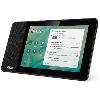Zoom Rooms can play music locally when the Timer alarm goes off.
Improvements
General features
Zoom Rooms voice commands are automatically re-enabled after exiting a meeting
- When a user temporarily disables Zoom Rooms voice commands from the Zoom Rooms controller or Zoom Rooms for Touch UI, the Zoom Room will automatically re-enable them after exiting the next Zoom meeting. This ensures voice commands will be available for the next user of the Zoom Room.
Upcoming meeting reminder overlay improvements
- Users can view the Zoom Room's top banner, including the room name, time, sharing key, and QR code, even when an upcoming meeting reminder is displayed. The top banner elements are positioned above the upcoming meeting notification, ensuring they remain visible.
Terminology update for optimized video sharing in Zoom Rooms
- The previous terminology "Optimize full-screen video sharing" has been updated to "Optimize for video sharing" in the Zoom Rooms Controller and Zoom Rooms for Touch user interface. This change aligns the terminology with other Zoom applications.
Support for multiple companion Zoom Rooms
- Admins can pair up to three companion Zoom Rooms for Touch to a main Zoom Room or Zoom Room for Touch. Each companion Zoom Room camera can be used in addition to the main room's cameras in a multi-camera system.
Save Zoom whiteboard on standalone whiteboards and companion Zoom Rooms via email
- Users can now save the content from a Zoom whiteboard opened on a standalone whiteboard or companion Zoom Room by emailing it to themselves or others.
Refresh button for Zoom Rooms
- Users can initiate a manual refresh of the Zoom Room hardware data by clicking the new refresh button, which is located next to the settings button. Clicking the refresh button will fetch the latest meeting data and upcoming reservations. This allows users to quickly update the Zoom Room display if there was a disconnection or other issue that prevented the automatic refresh from occurring.
Name tag size adjustment based on display size
- Users can now experience webinar name tags that dynamically adjust their size according to the screen dimensions of the Zoom Room display. This ensures that the name tags are always legible and properly scaled, preventing them from appearing too large or too small on the screen.
Enhancements to Zoom Rooms music playback for Timer alarms
- Zoom Rooms can play music locally when the Timer alarm goes off.
Disable AEC/noise suppression toggles for unsupported devices
- Admins can no longer see Acoustic Echo cancellation (AEC) or noise suppression toggles in the web settings for appliances that do not support these audio processing features. This prevents confusion when trying to configure unsupported settings.
Detect and utilize nearby Zoom Rooms from personal devices
- Users' personal devices can detect and promote Zoom Room features when in an office environment with nearby Zoom Rooms. They can share screens, push meetings, whiteboards, and applications to the detected rooms, or join companion mode. Administrators have control over which rooms are detectable, by whom, and can disable room detection altogether via the web portal.
Compatibility for macOS Sequoia
- Certain Zoom Rooms features, such as Airplay aka 'Screen Mirroring', Dante, Network Device Interface, and Native Room Controls, require permissions to work properly once a device is upgraded to macOS Sequoia. If these permissions are not granted, Users will see the following message in the Zoom Rooms app: "Local network permission not allowed. Quit the application and allow all Zoom Rooms applications to access the local network, as prompted. You may be asked to allow multiple permissions. Open System Preference > Privacy & Security > Local Network to allow access." Alternatively, this message will be displayed outside of the application if these features are enabled: "This process is needed to enable Zoom Rooms network a/v functions including Airplay, Dante, NDI, and NRC".
In-meeting features
Smart speaker tags
- Smart speaker tags Zoom smart speaker tags highlight individual speakers in a Zoom Room and display their names within meeting transcripts, and AI Companion summaries. Once enabled, Zoom will detect the meeting participant's voices and apply generic speaker tags (e.g. "Speaker 1"), or automatically apply the names of the users who have pre-enrolled with a voice recording. Smart speaker tags can be edited in-meeting via the Zoom Rooms controller.
Notification for joining third-party hybrid meetings
- Users receive a notification when joining a Zoom meeting hosted on a third-party's Zoom Node Meeting Connector. This notification alerts users to potential security risks associated with joining meetings hosted by external parties.
Improved multi-speaker layout and experience in Zoom Rooms
- The Zoom Rooms multi-speaker layout now follows the desktop client logic, including displaying two tiers of participants (active and inactive), transitioning participants between active and inactive states based on speech, and optimizing the layout for content sharing. The timing and animations for participant transitions have also been aligned with the desktop experience.
Improved handling of web links shared in Zoom Rooms meetings
- When a remote participant sends a web link in meeting chat, Zoom Rooms will display the link and offer users an alternative way to open it on their devices.
Enhancements to transforming meetings to private setting
- If an administrator has enabled the setting(s) to transfer a meeting to private or hide host and meeting ID from private meetings, the admin can now select to only transform the meeting to private on scheduling displays, while displaying the meeting name on the Zoom Room and Zoom Room controller.
Breakout rooms for webinar panelists and attendees
- Panelists and attendees in a Zoom Rooms webinar will have the same breakout room experience as in Zoom client sessions. This enhancement does not include webinar host controls from a Zoom Room.
Animated reactions in Zoom Rooms
- Users in a Zoom Room meeting can see animated reactions from other participants or the room itself. When a outside participant or the room sends an animated reaction, it will be displayed in an animated format that aligns with the desktop client experience.
Administrators using Personal Zoom Rooms can receive requests to enable AI Companion in-meeting features
- Users with Zoom account administrative privileges attending a Zoom meeting using a Personal Zoom Room can receive requests from other meeting participants to enable AI Companion features such as meeting summary and meeting questions.
Active speaker substream in multi-speaker layout for Zoom Rooms
- Users can see the best view of the person speaking in the multi-speaker video layout. If the room has the ability to identify the active speaker, the multi-speaker layout will show the substream of the active speaker instead of the entire room view.
Admin features
Use a Zoom Whiteboard as Digital Signage content
- Administrators can select a Zoom Whiteboard for a Digital Signage content list. They can set a "presentation frame" area of the whiteboard to display on the Zoom Room's screen. The Zoom Room will display the selected whiteboard content, updating in near real-time as changes are made to the whiteboard. This allows organizations to share important information from whiteboards with larger audiences.
Set maximum duration for instant Zoom Room reservations
- Administrators can set a maximum duration for instant room reservations from the Zoom Rooms scheduling display. They can configure this setting at the account, location, or individual Zoom Room level. If enabled, users cannot make instant reservations exceeding the set duration when using the scheduling display. The maximum duration setting overrides any workspace reservation restrictions.
Redesigned Zoom Rooms interoperability configuration
- Administrators can configure Zoom Rooms interoperability settings in a redesigned interface. The new settings are organized by service, with separate sections for Microsoft Teams, Google Meet, Webex, GoTo Meeting and Fuze. For each service, admins can enable or disable support for joining meetings using SIP or web client, and choose to display or hide the corresponding meeting join button on the Zoom Rooms home screen. Admins also have the option to use Pexip "SIP Guest Join" for Microsoft Teams meetings.
Override mute-on-entry setting for SIP/H.323 calls
- Administrators can enable a new setting to override the Mute all participants when they join a meeting option for SIP/H.323 calls made from Zoom Rooms. When enabled, this setting prevents the remote SIP/H.323 party from being muted when joining a Zoom Rooms or third-party meeting using SIP/H.323.
Override audio processing setting for Microsoft Teams meetings
- Administrators can override the Zoom Rooms logic and specify whether the Zoom Room should signal to the Microsoft Teams web client that the Zoom Room's audio peripherals can or cannot perform hardware/firmware audio processing. This setting can be enabled at the account, location, or Zoom Room level. If enabled, a sub-setting allows selecting between Microsoft Teams web client software audio processing or hardware audio processing.
Meeting details visibility control
- Administrators can set meetings as private on the scheduling display while allowing the meeting name and other information to be displayed on the Zoom Room screen and controller for room occupants.
Improved reboot behavior for companion Zoom Room devices
- When rebooting all devices, the connected Companion Zoom Room will also be rebooted along with the main Zoom Room and controller.
Disable Reserve Via Email button on scheduling displays and kiosks
- Admins can control the reservation methods available on scheduling displays and kiosks. They can disable the Reserve Via Email button, requiring users to authenticate via QR code to reserve resources. This ensures users must be physically present to make reservations, preventing remote reservations that could potentially bypass intended usage policies. The new setting is disabled by default.
Customizable font scaling for Zoom Rooms scheduling displays
- Administrators can adjust the font size of text shown on the Zoom Rooms scheduling display home screen. They can choose from three font scaling options: large, medium, or small. This setting allows them to control the density of information displayed, such as the room name, current time, upcoming meeting list, and status banners. The smaller font sizes enable more information to fit on the display.
Configurable calendar data display for Zoom Rooms
Administrators can configure Zoom Rooms to display only calendar data from the calendar integration. For Personal Zoom Rooms, this setting follows the user's calendar data configuration. For Shared Zoom Rooms, a separate setting is available to control the display of calendar data only. This setting ensures that the meeting list displays only appointments from the calendar integration.
Alerts for empty Digital Signage content list and inaccessible Whiteboards
- Administrators can configure alerts to be notified when a Zoom Room with Digital Signage enabled has an empty content list or contains only inaccessible Zoom Whiteboards. They can receive notifications via email or webhook when a Zoom Room is no longer showing Digital Signage content due to these issues.
Administrator controls for in-meeting chat emoji reactions
- Administrators can control which emojis are available for use in Zoom meeting chat. When specific emojis are selected, users in Zoom Rooms will only be able to react to meeting chat messages using the selected emojis.
Controller features
Enforce single Zoom Room Controller sign-in per workspace
- Admins can ensure that only one Zoom Room Controller (ZRC) is signed into a desk at a time. If a controller attempts to sign into a desk that is already signed into by another controller, the first controller will be logged out. This prevents multiple controllers from being simultaneously signed into the same desk.
Battery indicator for battery-powered Zoom Room Controllers
- Users with battery-powered Zoom Room Controllers can now view the battery level and charging state within the system banner at the top of the screen. The battery indicator is enabled by default for battery-powered ZRCs like the Crestron TST-1080 and DTEN Mate.
Resolved issues
- Minor bug fixes
- Security enhancements
- Resolved an issue where Airplay stopped working after a screen share.


